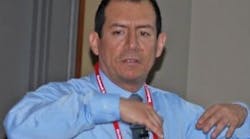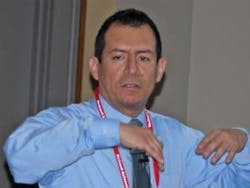"Unplanned downtime can cost us $100,000 per hour, so we faced a high risk of failure with high financial impact." Nexa’s Daniel Izarra on one of the many factors motivating the chemical manufacturer’s migration to the Rockwell Automation PlantPAx platform.
Extracting and separating pure zinc from other minerals and materials in its ore isn't easy to begin with, but it's much harder if your old, increasingly obsolete control systems can't communicate, lack spare parts, and don't have available technical expertise.These were some of the technical challenges faced by Nexa Resources at its zinc refinery near Lima, Peru. The company is the fourth largest producer of zinc worldwide, and its Cajamarquilla plant produces about 320,000 tons of zinc ingots and "jumbo" ingots per year.
However, most of its process control and automation technology was 15-20 years old, with many obsolete components that required spare parts and specialized expertise that was either unavailable or too costly, according to Daniel Izarra, senior automation engineer, Nexa Resources.
"For six years, we worked with a hybrid control system that was 50% from Rockwell Automation and 50% from another DCS manufacturer," said Izarra. "However, it was getting more obsolete, even though we'd done previous expansions with ControlLogix and CompactLogix components from Rockwell Automation. “We also had connectivity servers for each control system that couldn't talk to each other, and only allowed our more than 1,700 signals to be displayed on just one HMI with 60 different operator graphics.
"In addition, we had to maintain two different types of engineering stations, train users and maintain expertise for both, and find spare parts for them. Preventive maintenance wasn't possible because these components were just too old, and we couldn't get the right experts in. This was a big problem because unplanned downtime can cost us $100,000 per hour, so we faced a high risk of failure with high financial impact. We identified that partially obtaining spare parts would cost almost 50% of the total cost of a project."
Izarra presented "Nexa improves safety and reliability with legacy DCS modernization" this week at the Rockwell Automation Process Solutions Users Group meeting in Philadelphia.
Overcoming incompatibility
Izarra added that equipment such as groups of pumps in the primary leaching and purification applications at Nexa's Cajamarquilla plant might be controlled by either of its older control systems.
"Our challenge was to replace the old control systems that were incompatible with modern technology, and do it without impacting production," said Izarra. "We also had only one two-hour maintenance shutdown per week and one four-hour maintenance shutdown per month, which is when our migration had to be done. Also, system drawings weren't updated, and there was a scarcity of experts who knew the old system. Non-technical issues included the fact that operations staff was very familiar with the old controls, while refinery personnel were afraid to change the old, familiar DCS they knew so well. They were concerned changing the control system's wiring and programming could cause their processes to fail."
Consequently, Izarra reported that Nexa decided to build on its former ControlLogix and CompactLogix expansions, and integrate the remainder of its process controls into a unified PlantPAx distributed control system from Rockwell Automation. "We had some older components using ControlNet protocol, and the scope of our project included upgrading our communications network with redundant Ethernet; renewing workstations and servers; installing two remote I/O (RIO) cabinets, and upgrading with redundant CPUs."
To carry out its two-month migration project with minimal risk and optimal scheduling, Izarra explained that he and his team prepared by pre-identifying the refinery's signals, wiring and terminal blocks, and finely scheduling plant shutdowns in the two- and four-hour blocks available.
It also conducted pre-training in its existing control room, performed factory acceptance testing (FAT) with Nexa's technicians, established initial connections with the new Rockwell Automation platform, and migrated control loops for each functional area.
"We also ran the old and new control systems in parallel for two or three months, so our people could get familiar with the new solution, and we could add suggestions from the operators," added Izarra. "We started with non-critical loops and signals, and just migrated pump by pump. We were able to do a lot of the migration while the plant was running, so we didn't have to wait for shutdown periods. This was enabled by pre-identifying the signals and wires, and let us have less of an impact on our systems."
Optimization gained
In the wake of its control system migration and upgrade, Nexa achieved a variety of improvements, according to Izarra. These included:
-
Reliability of the hydrometallurgy application's control system reached 100%;
-
Safety incidents due to DCS shutdowns were reduced to zero, though just from one event had occurred during the previous five years;
-
Nexa presently has technical support available;
-
Refinery owns required spare parts; and,
-
Incremental integration of migration kept costs low.
"We also learned that fine scheduling is required for brownfield automation projects to succeed, and that plant staff such as operators and maintenance must be involved from the beginning of a migration project," added Izarra.
"In addition, validation of technical documentation is necessary to avoid delays during intervention periods,” he said. “Also, continuous communication and coordination with the operations and maintenance areas are critical to develop the planning, control and executions of these projects. Finally, a contingency plan should be prepared and delivered to all areas before initiating migration."
The editors of Control are on-site at Automation Fair 2018 to bring you breaking news, innovations and insights from the event. Once the event is over, they will put together a report featuring the top news. Pre-order your copy today.
[javascriptSnippet]







